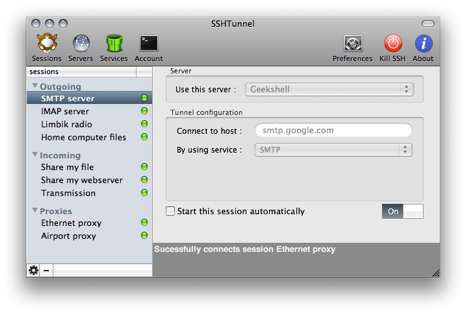

Running the ps aux command again will reveal that the background process is no longer running. When using SSH Tunneling, the Connect to Serverdialog will prompt for the SSH Tunnel and Database server passwords if not already saved. Also, unrelated, but if you want to avoid ssh, PostgreSQL can be reached remotely over TLS and you can restrict the source IPs both at the OS firewall level (iptables) and in PostgreSQL nf settings. Also look at your remote postgresql instance log files. jason 6674 0.0 0.0 48280 912 ? Ss 21:15 0:00 ssh -Nf -L the PID we can kill the background process by doing. Make sure to use same username/password in both cases. The number we’re interested in is the PID, which is the second number below. This runs the command ps aux and returns any lines containing 3333 (the port we bound to locally). If you sent it into the background using -f then you will need to kill the command by finding the background process using ps aux and grep. If you ran the command as suggested, CTRL+C in the terminal will kill the SSH tunnel. Using pgAdmin, connect as you would to a local database except use the port we’ve bound to (3333): If you want the command to go into the background so you can continue to use the terminal, add an -f argument. In our case we’re asking that port 3333 on localhost be bound to localhost:5432 from the remote server.
Pgadmin ssh tunnel password#
Why is this Extra details: Ive set a master password for the app When I click save, it connects fine, but on restarting pgAdmin and entering my master password, when I connect to this server again Im asked to enter the SSH key. L: This is the bind target on the local client. In the SSH Tunnel tab, the 'Save password' field is greyed out, even when Ive filled in all of the fields.ssh -N -L 3333:localhost:5432 N: Do not execute a remote command. You can use the SSH Tunnel tab to connect pgAdmin (through an intermediary proxy host) to a server that resides on a network to which the client may not. The first step is to create an SSH tunnel.

Fortunately, it is very straight forward to setup by creating an SSH tunnel to the remote server and then connecting pgAdmin to the server as if it’s on localhost. Then, configure the connection as follows: Enter your server’s IP address in the Hostname/ Address field. First select the Connection tab in the Create-Server window. When working with remote PostgreSQL databases it’s nice to be able to use a graphical user interface to manage the data. django database-connection pgadmin 64,638 Solution 1 You can configurate your newly created server to run on localhost and port 5432.


 0 kommentar(er)
0 kommentar(er)
